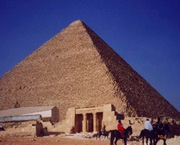
Archaeologists
have uncovered the first example of a lion mummified by the ancient
Egyptians, in the tomb of the woman who helped rear King Tutankhamun.
Although the breeding and burial of lions as sacred animals in
Egypt is mentioned by ancient sources, to date no one had found
a mummified specimen.
The male lion is amongst the largest known to science and its
bones show it lived to an old age in captivity.
Details of the discovery are published in the scientific journal
Nature.
The lion was found in a tomb at Saqqara in northern Egypt belonging
to Maia, wet nurse to Tutankhamun, who was buried in about 1430
BC.
However, in the last centuries BC, the tomb was re-used for the
burial of humans and then animals - mostly mummified cats.
Analysis of the teeth, particularly the wear on them, show that
the lion lived to be very old and must have been kept in captivity.
Alan Lloyd, professor of classics and ancient history at the
University of Wales, Swansea, said: "The lion is a creature
that has a long association with the king [of Egypt]. The king
was thought of as a lion and as having the qualities of a lion.
The qualities the Egyptians were interested in, of course, were
martial."
In the last few centuries BC, Egypt was under invasion by waves
of outsiders, from Iraq, Nubia (which today comprises parts of
Sudan and Egypt) and Greece.
The surge of interest in animal cults may be the ancient Egyptians'
way of asserting their identity in the presence of these newcomers.
"I think this should be regarded as an expression of Egyptian
nationalism," said Professor Lloyd.
Professor Lloyd said he had heard rumours in the early 1970s
of a mummified lion being found in Egypt. However, the person
excavating the lion apparently was not interested in it and the
location of the find was lost.
The lion was found lying on a rock with its head turned north
and its body orientated toward the east. Its bone measurements
are amongst the largest ever recorded for a male lion.
In addition to cats, the Egyptians also mummified dogs, birds,
snakes and monkeys.
(Agencies)
